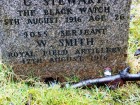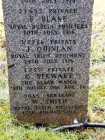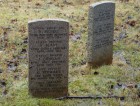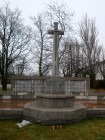 Gilshochill is the third station on the railway line from Glasgow Queen Street station on route to Anniesland. A return ticket for Gilshochill is £2.60p.The entrance to the Glasgow Western Neocropolis cemetery is approx. quarter mile from the station along Tresta road. Upon entering the cemetery, immediately take the first road to the left, which encircles a very old part of the cemetery ( areas B and H ). The road falls rapidly downhill and turns slowly to the right. At the bottom of the hill you will see 6 No. CWGC headstones in a row.About 5 metres beyond these, there are 2 more headstones : one of these includes the epigraph for Sergeant William Smith.This particular area of the cemetery ( B and H ), which is only a fraction of the overall area, is in a very poor state. Probably 75 - 80% of the original headstones or memorials are either fallen flat or missing because of the steep slope and the poor ground conditions. The CWGC headstones are the exception to this.The Glasgow Family History Society have photographed over 4600 headstones and monuments over the last 10 years, but these are not available on-line.
Gilshochill is the third station on the railway line from Glasgow Queen Street station on route to Anniesland. A return ticket for Gilshochill is £2.60p.The entrance to the Glasgow Western Neocropolis cemetery is approx. quarter mile from the station along Tresta road. Upon entering the cemetery, immediately take the first road to the left, which encircles a very old part of the cemetery ( areas B and H ). The road falls rapidly downhill and turns slowly to the right. At the bottom of the hill you will see 6 No. CWGC headstones in a row.About 5 metres beyond these, there are 2 more headstones : one of these includes the epigraph for Sergeant William Smith.This particular area of the cemetery ( B and H ), which is only a fraction of the overall area, is in a very poor state. Probably 75 - 80% of the original headstones or memorials are either fallen flat or missing because of the steep slope and the poor ground conditions. The CWGC headstones are the exception to this.The Glasgow Family History Society have photographed over 4600 headstones and monuments over the last 10 years, but these are not available on-line.Glasgow Western Necropolis Cemetery
View Glasgow Western Necropolis Cemetery on the Commonwealth War Graves Commission websiteGlasgow
Scotland
Scotland
About
Glasgow was one of the ports of embarkation for the British Expeditionary Force in 1914 and several military hospitals opened in the city during the First World War, including the 3rd and 4th Scottish General (1,200 beds each), and the Merryflats War Hospital (500 beds). Battalions of a number of Scottish regiments had their headquarters at Glasgow during both wars, most notably the Highland Light . The cemetery contains 355 First World War burials, many of them grouped together in Section P, with a small group of Australian graves in Section N.

|
Do you know something about Glasgow Western Necropolis Cemetery that hasn't been mentioned? You can add any new information and images as a contribution at the bottom of this page. |
1 Rutlander remembered here
SMITH
William
From Cottesmore
View details
User contributions
 Gilshochill is the third station on the railway line from Glasgow Queen Street station on route to Anniesland. A return ticket for Gilshochill is £2.60p.The entrance to the Glasgow Western Neocropolis cemetery is approx. quarter mile from the station along Tresta road. Upon entering the cemetery, immediately take the first road to the left, which encircles a very old part of the cemetery ( areas B and H ). The road falls rapidly downhill and turns slowly to the right. At the bottom of the hill you will see 6 No. CWGC headstones in a row.About 5 metres beyond these, there are 2 more headstones : one of these includes the epigraph for Sergeant William Smith.This particular area of the cemetery ( B and H ), which is only a fraction of the overall area, is in a very poor state. Probably 75 - 80% of the original headstones or memorials are either fallen flat or missing because of the steep slope and the poor ground conditions. The CWGC headstones are the exception to this.The Glasgow Family History Society have photographed over 4600 headstones and monuments over the last 10 years, but these are not available on-line.
Gilshochill is the third station on the railway line from Glasgow Queen Street station on route to Anniesland. A return ticket for Gilshochill is £2.60p.The entrance to the Glasgow Western Neocropolis cemetery is approx. quarter mile from the station along Tresta road. Upon entering the cemetery, immediately take the first road to the left, which encircles a very old part of the cemetery ( areas B and H ). The road falls rapidly downhill and turns slowly to the right. At the bottom of the hill you will see 6 No. CWGC headstones in a row.About 5 metres beyond these, there are 2 more headstones : one of these includes the epigraph for Sergeant William Smith.This particular area of the cemetery ( B and H ), which is only a fraction of the overall area, is in a very poor state. Probably 75 - 80% of the original headstones or memorials are either fallen flat or missing because of the steep slope and the poor ground conditions. The CWGC headstones are the exception to this.The Glasgow Family History Society have photographed over 4600 headstones and monuments over the last 10 years, but these are not available on-line.By marko-12 on Friday 30th March '18 at 9:35am
Rutland and The Battle of the Somme
More than 90 Rutland soldiers died in the Battle of the Somme which lasted from 1 July 1916 until the middle of November. Today they lie in cemeteries across the old battlefield in northern France or are remembered among the 72,000 names on the Thiepval Memorial to the Missing of the Somme. By using our interactive map, you can find out what happened to them.







.png)


.jpg)





Please wait